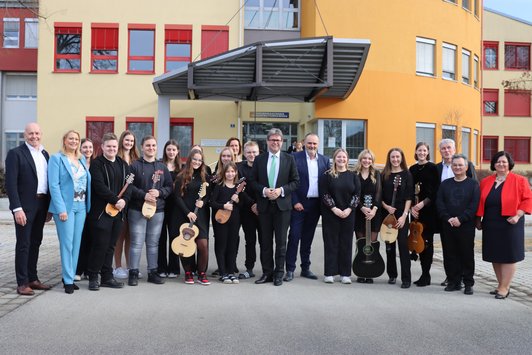242 Gedenkzeichen von NS-Opfern im Burgenland sind ab sofort Teil der digitalen Erinnerungslandschaft DERLA
Am 5. Februar 1995 fielen vier Oberwarter Roma einem rechtsextremen Bomben-Attentat zum Opfer. An diesem Jahrestag präsentierten Österreichs Bildungsagentur OeAD gemeinsam mit dem Centrum für Jüdische Studien der Universität Graz, der Privaten Pädagogischen Hochschule Burgenland und Vertreterinnen und Vertretern der Volksgruppe der Roma unter Anwesenheit von Bildungsminister Martin Polaschek und Landeshauptmann Hans Peter Doskozil die Erweiterung der digitalen „Erinnerungslandschaft“ Österreichs (kurz DERLA) um das Land Burgenland. Die Veranstaltung fand am Bundesgymnasium Oberwart statt.
Erinnerungsorte auf einer digitalen Landkarte
DERLA ist ein Dokumentations- und Vermittlungsprojekt. In einer digitalen Karte werden die Erinnerungsorte und -zeichen der Opfer und Orte des Terrors des NS-Regimes in Österreich dokumentiert. Zu den jeweiligen Erinnerungsorten wurden die Biografien der Opfer der nationalsozialistischen Verfolgung recherchiert, für Schulen und die Öffentlichkeit werden digitale Rundgänge zu den Erinnerungszeichen angeboten. Das Vorhaben leistet einen wichtigen Beitrag zur schulischen Geschichtsvermittlung. Es wird vom BMBWF, vom Nationalfonds und Zukunftsfonds der Republik Österreich sowie vom Amt der Burgenländischen Landesregierung finanziell unterstützt. In DERLA sind aktuell 1.874 Erinnerungszeichen und -Orte, 2.915 Biografien und 83 Vermittlungsangebote abrufbar, davon 242 Erinnerungszeichen und 99 Biografien von NS-Opfern aus dem Burgenland
Das interdisziplinäre Kooperationsprojekt widmet sich zudem der Entwicklung neuer Konzepte einer digitalen Erinnerungspädagogik und bietet konkrete Angebote für Vermittlungsarbeit.
Wie funktioniert DERLA?
Die Plattform besteht aus vier wesentlichen Elementen: Eine interaktive Karte der Erinnerung führt zu Erinnerungsorten und -zeichen und macht deren Geschichte sichtbar. Im Archiv der Namen werden alle, die auf den Erinnerungszeichen genannt und erinnert werden, biografisch vorgestellt. Im Vermittlungsportal finden sich Angebote für die schulische Vermittlungsarbeit. Die Wege der Erinnerung verbinden die Erinnerungsorte. www.erinnerungslandschaft.at
„Der schulische Besuch von lokalen Gedenkorten ist pädagogisch besonders wertvoll und wird von DERLA niederschwellig ermöglicht. Lokale Erinnerungszeichen docken an der Lebensrealität von Schülerinnen und Schülern an, weil sie in unmittelbarer Nähe der Schulen und Wohnorte stehen und so eine lebendige Geschichtsvermittlung ermöglichen,“ so Bildungs-, Wissenschafts- und Forschungsminister Martin Polaschek über DERLA.
„Mit der digitalen Erinnerungslandschaft wird NS-Geschichte im Burgenland virtuell sichtbar gemacht. Die Geschichte zeigt, wie schwer es die Roma und Sinti hatten. Eine Auseinandersetzung mit unserer Vergangenheit ist wichtig für eine lebendige Erinnerungskultur - und gleichzeitig ein Auftrag, auch im Jetzt und Heute gegen Diskriminierung, Ausgrenzung und Verhetzung mit aller Vehemenz aufzutreten,“ unterstreicht Landeshauptmann Hans Peter Doskozil die Bedeutung des Projekts.
Emerich Gärtner-Horvath, Vorsitzender des Volksgruppenbeirats für die Roma und Obmann des Vereins Roma-Service, in seiner Grußbotschaft: „Die Aufarbeitung unserer gemeinsamen Geschichte, insbesondere meiner Volksgruppe, war mir persönlich, ein großes Anliegen. Meine drei Geschwister, Josef, Berta und Karl, wurden mit meinen Großeltern verschleppt. Die Großeltern sind in Auschwitz ermordet worden. Was jedoch mit meinen drei Geschwistern passiert ist, weiß ich bis heute nicht. Ich weiß nicht, was mit ihnen geschehen ist, wohin sie verschleppt wurden. Nach Lodz oder woanders hin? Mich und auch andere Mitglieder meiner Volksgruppe, denen es genauso ergangen ist, beschäftigt dies noch heute. ERINNERN:AT (OeAD) engagiert sich seit langem auch für die Erinnerung an die während der NS-Zeit verfolgten und ermordeten Romnja und Roma. Für diese wichtige Tätigkeit möchte ich mich als Vorsitzender des Volksgruppenbeirats der Roma, bei allen Mitwirkenden recht herzlich bedanken.“
Jakob Calice, OeAD-Geschäftsführer betont: „Wo und von wem wird wie erinnert? DERLA, als digitale Erinnerungslandschaft, steht für zeitgemäße historische Bildung zum Nationalsozialismus und Holocaust. Mit DERLA können Schülerinnen und Schüler auf lokale Spurensuche gehen – ob Denk- oder Mahnmäler, Gedenkstätten oder Gedenktafeln. Sie lernen, konkrete Bezüge zur Vergangenheit herzustellen. Sie beschäftigen sich kritisch mit dem Nationalsozialismus und den damit einhergehenden Auswirkungen auf die Gesellschaft und Politik bis heute.“
Gerald Lamprecht, Leiter Centrum für Jüdische Studien, Universität Graz und Herbert Brettl, Netzwerk-Koordinator Burgenland für das OeAD-Programm ERINNERN:AT erläutern „Die kontinuierlich erweiterte DERLA-Plattform dokumentiert in einer digitalen Erinnerungskarte erstmals alle Erinnerungszeichen an die Opfer des Nationalsozialismus. Sie verknüpft die Dokumentation mit dem Lernen über den Nationalsozialismus und Holocaust. Von den insgesamt 242 im Burgenland erfassten Erinnerungszeichen, sind 26 dem Genozid an den Burgenländischen Roma gewidmet. Der Großteil der in Burgenland ansässigen Roma wurden in der NS-Zeit verschleppt und ermordet. Nach der Befreiung sind nur wenige zurückgekehrt. Vielen wurde der Neuanfang schwer bis unmöglich gemacht. Erst spät wurde damit begonnen, an die Verbrechen an den Roma zu erinnern und erste Erinnerungszeichen zu errichten – meist durch die Volksgruppe selbst. Mehr als die Hälfte der Erinnerungszeichen wurde erst in den letzten zehn Jahren initiiert. Mit DERLA machen wir diese nun für ein breites Publikum sichtbar. Und für Schülerinnen und Schüler haben wir in Kooperation mit der Privaten Pädagogischen Hochschule Burgenland Vermittlungsangebote entwickelt.“
Ute Leonhardt, Private Pädagogische Hochschule Burgenland erklärt: „Das Vermittlungsangebot richtet sich an Schülerinnen und Schüler, die dadurch die Möglichkeit erhalten, sich mit dem Nationalsozialismus und seinen Opfergruppen auseinanderzusetzen.
Die Aufgaben beschränken sich nicht nur auf die klassische Quellenanalyse, sondern sind abwechslungsreich und kreativ gestaltet. Indem die Lernenden historische Informationen untersuchen, bewerten und interpretieren, entwickeln sie ein Geschichtsbewusstsein, das zur Bildung einer kritischen und reflektierten Perspektive auf die Vergangenheit und die Gegenwart beiträgt. Ebenso ermöglicht es den Lernenden, ihre eigene Identität zu verstehen und gesellschaftliche Prozesse zu analysieren und somit aus der Geschichte zu lernen.“
DERLA Burgenland ist ein Kooperationsprojekt von OeAD, der Universität Graz (Centrum für Jüdische Studien, Zentrum für Informationsmodellierung) sowie der Privaten Pädagogischen Hochschule Burgenland. Gefördert wird das Vorhaben vom BMBWF, dem Land Burgenland, dem Zukunftsfonds der Republik Österreich und dem Nationalfonds der Republik Österreich für die Opfer des Nationalsozialismus. DERLA wird im Burgenland vom Netzwerk-Koordinator für das OeAD-Programm ERINNERN:AT umgesetzt. DERLA gibt es bereits für die Steiermark, Vorarlberg, Tirol und Kärnten.
Die Veranstaltung bildet den Auftakt des Jahresschwerpunkts des OeAD-Programmes ERINNERN:AT zum Genozid an den europäischen Roma und Sinti während der NS-Zeit.

